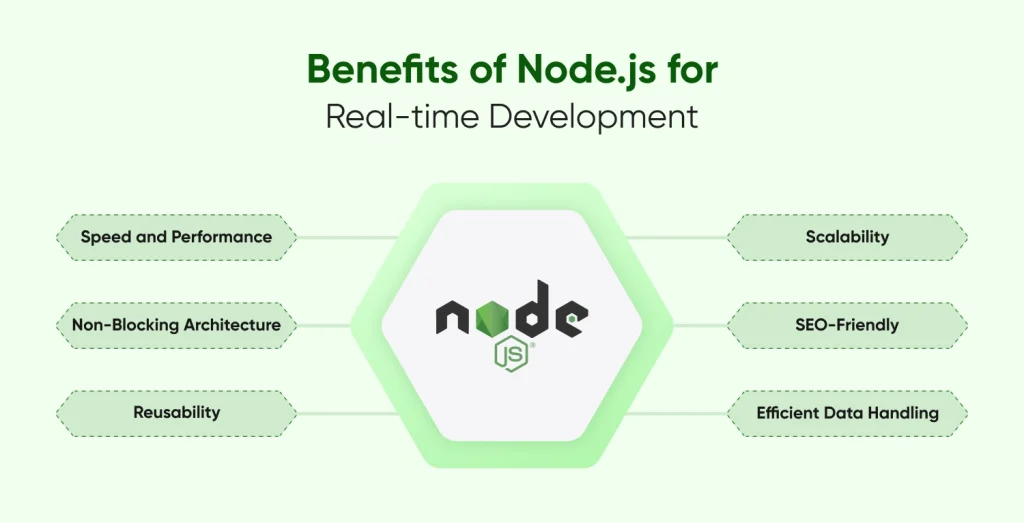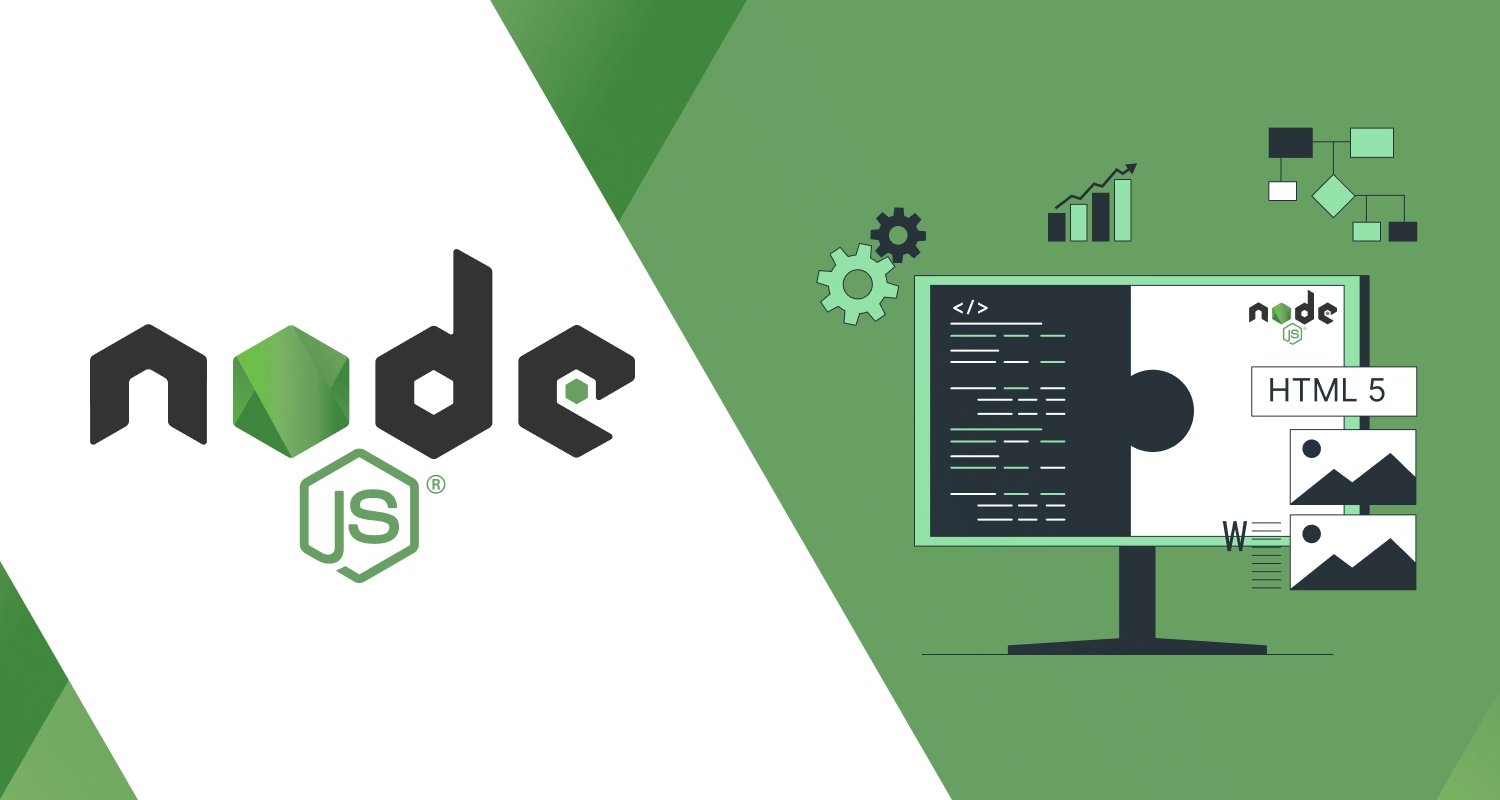These days, almost everything can be done with just one click over the internet. We all become lazy in the digital age and use it as an excuse to focus on efficiency. As customer expectations are at an all-time high, there is no way out for organizations or app developers. Consumers desire quick and simple services free from third-party app restrictions.
In this post, we examine a few of the benefits of Real-time app development with Node.js. Real-time app development is undergoing significant changes and will eventually witness ground-breaking breakthroughs.
Discover why Node.js is a widely used tool to build real-time applications with NodeJS by reading on:
What is a Real-Time Application?
Users expect instant responses from their apps in today’s fast-paced environment. Real-time features are now essential for modern applications. They enhance experiences by providing quick updates. This is especially important for activities like receiving messages or tracking deliveries. Furthermore, live video calls rely heavily on these capabilities.
Node js real-time applications examples include:
- eCommerce Transactions that display inventory updates instantly
- Instant Messaging services such as WhatsApp or Slack
- Online Multiplayer Games where players interact in real-time
- Live Video Streaming platforms like YouTube Live or Twitch
Why Choose Node.js for Real-Time Application Development?
Let’s explore why Node.js is a superior framework for Developing Node Js Real TimeApplications.
Event-Driven Architecture
One of the primary reasons Node.js is perfect for real-time applications is its event-driven architecture. This design is a must-have for building real-time apps. These apps often have multiple users interacting simultaneously. This interaction leads to various activities, such as data updates, notifications, and message sending. Node.js’s event-driven architecture efficiently manages these events. It does so without straining the server’s resources. A smooth, continuous user experience is the outcome.
Asynchronous, Non-Blocking I/O
Data must go between the server and the client seamlessly in real-time applications. Maintaining this continuous flow is essential to a positive user experience. With asynchronous programming and non-blocking I/O, Node.js can handle several requests at once. This capability prevents the application from stuttering during heavy use.
Scalability
One important part is Node.js scalability for real-time applications. Users will interact with your real-time app more frequently as it becomes more well-known. This increase in user activity is a positive sign of its success. Since Node.js is scalable, supporting hundreds or even millions of concurrent users can be accommodated without sacrificing performance. Applications such as social networking sites, online gaming, and live streaming services require this in particular.
Speed
It’s imperative to move quickly while developing real-time applications. The V8 engine from Google is essential for Node.js. It translates JavaScript into machine code very quickly. This capability ensures high performance for your applications. As a result, your application can efficiently handle a lot of real-time data. This efficiency is crucial, especially for applications requiring quick responses and smooth user experiences.
NPM Ecosystem
One other benefit of Node.js is its extensive ecosystem of NPM packages. There’s a vast array of pre-built packages available for developers. These packages help to expedite development and simplify applications. They also add essential functionality to projects.
The Node.js ecosystem includes everything needed to implement interactive features. You can easily integrate real-time messaging into your applications. Additionally, it supports live data changes, enhancing user experience.

Real-Time Use Cases for Node.js
After discussing the reasons why to make node js app, let’s examine some real-world situations where Node.js real-time applications really shine.
Real-Time Messaging
A lot of applications are built around real-time messaging. These consist of WhatsApp, Facebook Messenger, and Slack. To guarantee instantaneous message delivery, these platforms necessitate continuous data interchange between users and servers. Because of its non-blocking architecture, Node.js makes sure that messages are transmitted and received instantly.
Node.js is ideal for messaging applications, teamwork tools, and customer service chat systems since it facilitates effective administration of user connections and message broadcasting.
Real-Time Notifications
In contemporary applications, real-time notifications are now a basic functionality. Users want to know right away when they receive notifications. This includes system alerts, reminders, and push notifications about new messages. Real-time notification delivery is one of Node.js’s strongest features. It ensures users stay informed and engaged with your application.
Real-time alerts greatly enhance user experience; they can be used by eCommerce platforms to notify users of price changes or by social media apps to convey likes and comment updates. You can build with node js scalable, fast notification systems that increase user interaction.
Real-Time Tracking
Applications like logistics platforms, food delivery services, and taxi services rely on real-time tracking. This feature keeps users updated on their orders, shipments, or rides instantly. Node.js makes developing such tracking services seamless, offering real-time updates to users. The result? Increased transparency that boosts customer satisfaction.
Take Uber, for example. Their real-time tracking feature, powered by Node.js, updates users about their driver’s location, route, and estimated arrival time. This constant flow of information reassures users, making the experience more reliable.
Internet of Things (IoT)
Real-time communication is crucial for the IoT business. For instance, linked cars can share data instantly with the cloud. Smart thermostats also contribute by regulating the temperature in your home. Because of its scalability and effectiveness in managing several device connections at once, Node.js Best Practices are a great choice for Internet of Things applications.
Benefits of Node.js for real-time development
Let’s dive deeper into the key benefits of using Node.js for real-time application development:

Speed and Performance
The robust V8 engine, created by Google, is the foundation of Node.js. This engine greatly speeds up execution by immediately compiling JavaScript into machine code. This leads to the capacity to manage massive data and traffic volumes with little delay for real-time applications. Node.js guarantees that data is handled quickly, resulting in a seamless user experience, especially when customers anticipate prompt responses, like during online multiplayer games, video calls, or live chat. Due to the fact that real-time apps depend on prompt feedback to maintain user engagement, this performance gain becomes essential.
Non-Blocking Architecture
Node.js Streams can handle multiple requests at once. This is possible due to its event-driven nature. Its non-blocking I/O architecture plays a key role in this ability. To ensure that no process is delayed while waiting for another to finish, Node.js uses asynchronous programming to get around this restriction. When several users may be interacting with a system simultaneously, such as in real-time applications, this functionality is useful. Even when your app is heavily used, the non-blocking architecture makes sure it functions properly and keeps users updated in real-time.
Reusability
One of Node.js’s greatest qualities is its support for reusability. Developers can reuse modules and components, saving a lot of time and effort. This makes the development process faster and more efficient. Additionally, Node.js offers a massive collection of pre-built, reusable components. These components can be easily integrated into applications. This is possible thanks to the Node Package Manager (NPM). As a result, less code is duplicated and teams are free to concentrate on creating original features rather than creating the wheel. In large-scale real-time applications, where development cycles must be quick and effective, reusability is extremely beneficial.
Scalability
Scalability is like as when developing real-time apps, especially as your user base expands. Node.js is quite good at managing an increasing amount of simultaneous connections. Node.js scales both vertically and horizontally, so regardless of the number of users your app serves thousands or millions performance is maintained even when demand rises. Because of this, Node.js is a popular choice for programs where performance cannot lag despite fluctuations in the number of active users, such as social media platforms, streaming services, and online gaming. Because of its lightweight design, any web application development company can operate it on several servers or cloud services, guaranteeing scalability constantly.
SEO-Friendly
In the current digital environment, search engine optimization, or SEO, is essential to an app’s success. The ability of Node.js to improve SEO performance through backend rendering is one of its more subtle advantages. JavaScript-heavy pages may be difficult for search engines to crawl and index when using typical client-side rendering. On the other hand, Node.js enables server-side rendering, guaranteeing that search engines like Google can see your content. This raises your real-time application’s visibility, search engine ranks, and ultimately organic traffic. This SEO-friendly feature is essential for web application development to remain competitive.
Efficient Data Handling
An essential feature of a real-time application is its instantaneous data management and display capabilities. In this regard, Node.js Performance excels, enabling seamless data flow between the client and server. Node.js makes sure that data is transferred and rendered quickly, regardless of whether you’re managing massive data sets in a dashboard, processing real-time analytics, or updating numerous people in a live chat. This is essential for developing real-time information updating user experiences for applications like stock market apps, teamwork tools, and live-streaming platforms.
Conclusion
Building real-time applications demands a robust, scalable, and high-performance platform. Node.js fits this requirement perfectly. Its event-driven architecture allows for efficient handling of multiple tasks simultaneously.
Whether it’s a chat app, real-time tracking system, or live streaming platform, Node.js delivers consistently. It guarantees that, even with a high load, your program provides a flawless user experience. If you’re prepared to advance your project, think to hire Node.js developers. If you have the right information, you can develop scalable, high-performing apps that flourish in the current competitive market.
Frequently Asked Questions
Is node JS good for real-time applications?
Real-time interactions and tasks requiring a large amount of data handling benefit greatly from the event-driven, non-blocking I/O processing environment provided by Node.js. Its asynchronous, single-threaded architecture enables it to scale apps well and manage several links at once.
How to develop real-time applications?
To build real-time apps, leverage technologies such as cloud platforms, WebSockets, and Node.js. In order to ensure fast, synchronized user experiences, low latency architecture, efficient data management, and stable connectivity should be prioritized.
How secure is Node.js for real-time application development?
Node.js leverages technologies like WebSockets and Socket.io. These tools enable real-time communication between the client and server. It enables real-time collaboration, chat, alarms, and live feeds for apps. Connect with the best Node.js development company to get the right info.
What are some popular real-time applications built with Node.js?
Some of the top Node js real-time applications examples include
1. Uber
2. Slack
3. Trello
4. Discord
5. Netflix
These apps prove that Node.js scalability for real-time applications can be utilized in tough environments and still be scalable, quick, and real-time.
Can I use Node JS for an eCommerce app?
Developers may create scalable network apps with Node.js, a JavaScript runtime environment. It is compatible with several programs, including e-commerce platforms. Node.js is designed to provide e-commerce apps with great performance and speed. There are also several applications Node js example Node apps.







